The Best Linden Tree Varieties to Plant in Your Garden
Published: October 23, 2025 at 9:36:05 PM UTC
Linden trees bring a perfect combination of beauty, fragrance, and ecological benefits to home gardens. With their heart-shaped leaves, sweet-scented summer blooms, and majestic presence, these versatile trees create inviting outdoor spaces while supporting local pollinators. Whether you're looking for a stately shade tree, a fragrant focal point, or a wildlife-friendly addition to your landscape, the right Linden variety can transform your garden for generations to come.
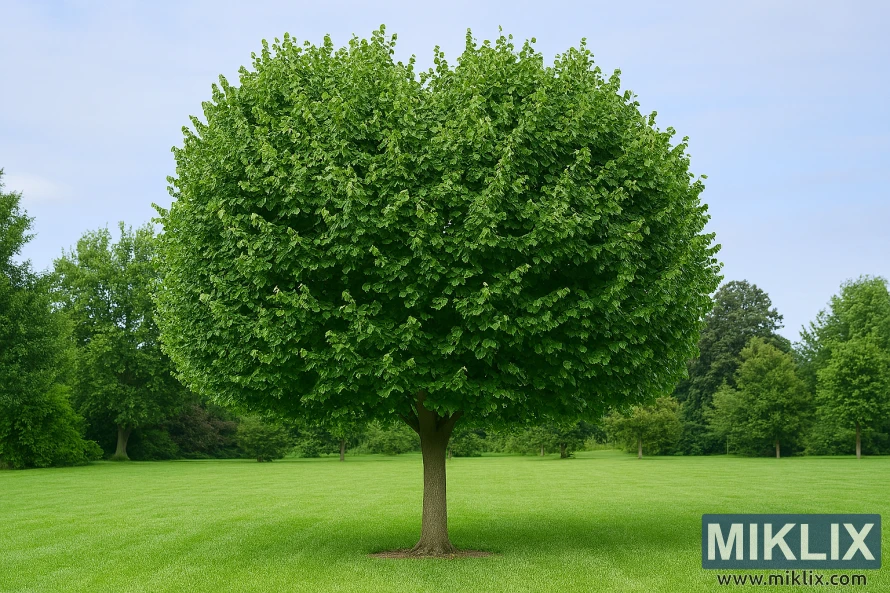
In this comprehensive guide, we'll explore the most garden-friendly Linden tree varieties, their unique characteristics, and how to select the perfect one for your specific needs. From compact cultivars ideal for smaller yards to magnificent specimens that create cooling shade, you'll discover why Lindens have been beloved landscape trees for centuries.
Why Linden Trees Deserve a Place in Your Garden
Before diving into specific varieties, let's explore what makes Linden trees such exceptional additions to residential landscapes. These remarkable trees offer multiple benefits that extend well beyond their ornamental value.
Shade & Structure
Linden trees develop dense, symmetrical canopies that create cooling shade during hot summer months. Their naturally pyramidal to oval shape provides architectural structure to garden designs, while their substantial size makes them perfect specimen or shade trees.
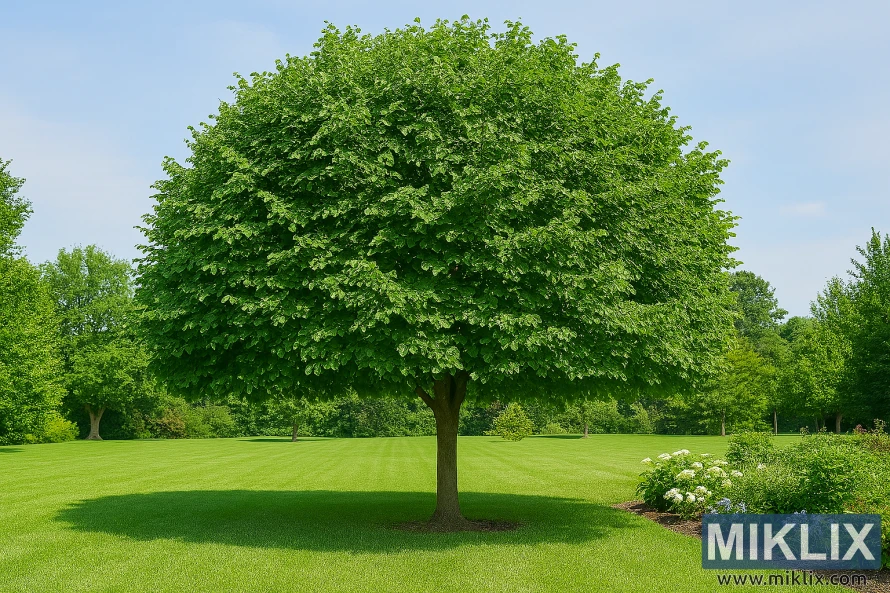
Fragrance & Flowers
One of the Linden's most cherished features is its intensely fragrant summer blooms. The small, creamy-yellow flowers hang in clusters beneath specialized leaf-like bracts, filling the air with a sweet honey-like scent that can perfume an entire garden. These blossoms later transform into interesting seed pods that add visual interest.
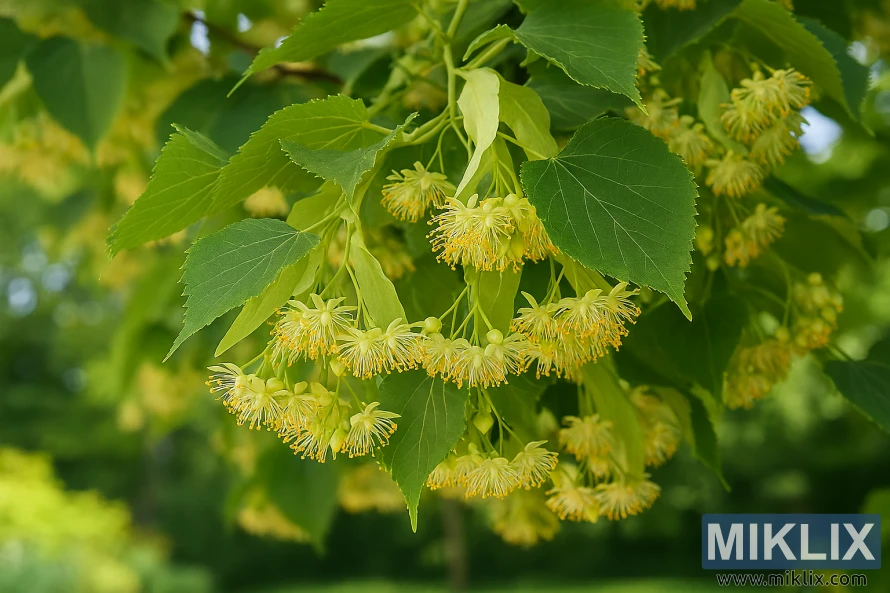
Wildlife Support
Linden trees are exceptional pollinator magnets. When in bloom, they attract countless bees, butterflies, and beneficial insects. The resulting "Basswood honey" is prized for its light color and distinctive flavor. Birds also benefit from the seeds and the insects that the trees attract, making Lindens valuable additions to wildlife-friendly gardens.
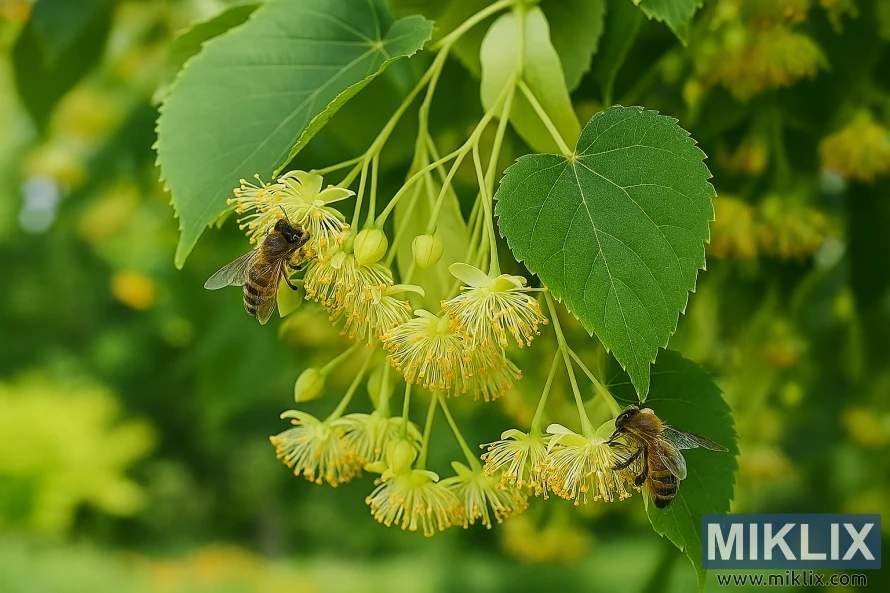
Adaptability & Longevity
Once established, many Linden varieties show remarkable tolerance to urban conditions, including pollution, compacted soil, and occasional drought. They're also exceptionally long-lived trees, with some specimens surviving for hundreds of years, making them true legacy plantings that can be enjoyed by future generations.
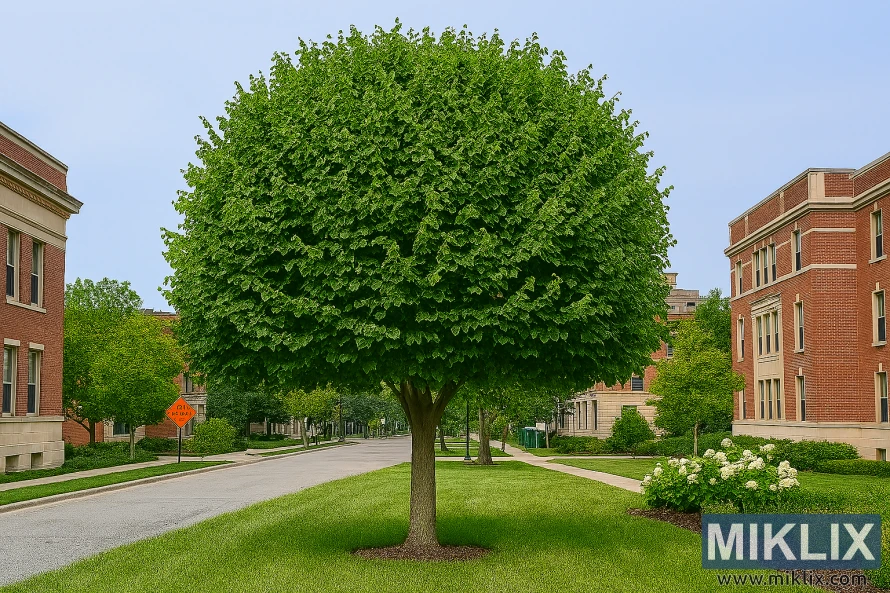
Top Linden Tree Varieties for Home Gardens
With dozens of species and cultivars available, selecting the right Linden tree can feel overwhelming. We've narrowed down the options to the six most garden-friendly varieties, each offering unique characteristics to suit different landscape needs.
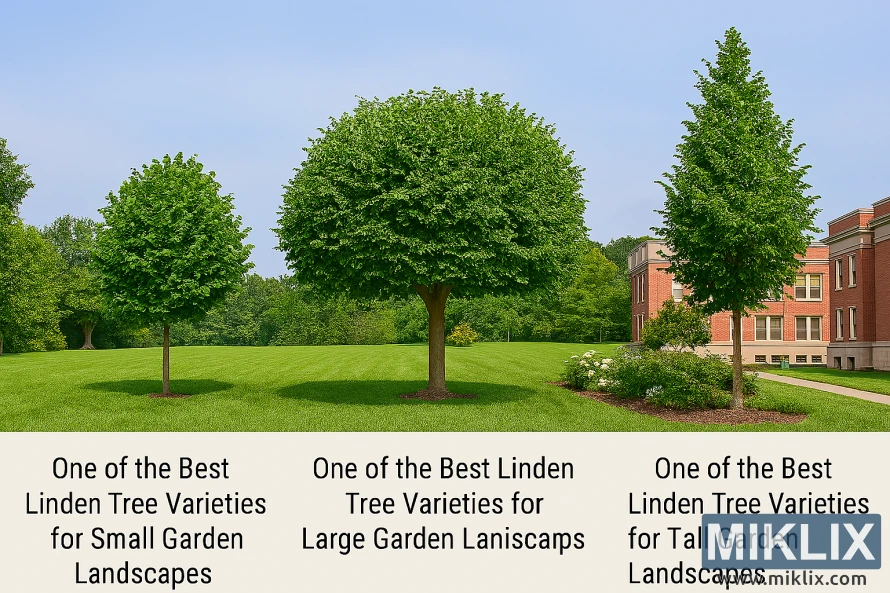
Littleleaf Linden (Tilia cordata)
The Littleleaf Linden is perhaps the most versatile and widely planted Linden species in residential landscapes. Native to Europe, this refined tree features smaller, more delicate foliage than other Lindens while maintaining the classic heart-shaped leaf form. Its compact size makes it suitable for medium to large gardens where space might be a consideration.
In summer, the tree produces abundant fragrant yellow flowers that attract bees and butterflies from far and wide. The Littleleaf Linden's naturally pyramidal shape requires minimal pruning to maintain its elegant form, and its fall color ranges from yellow to golden-brown, adding seasonal interest.
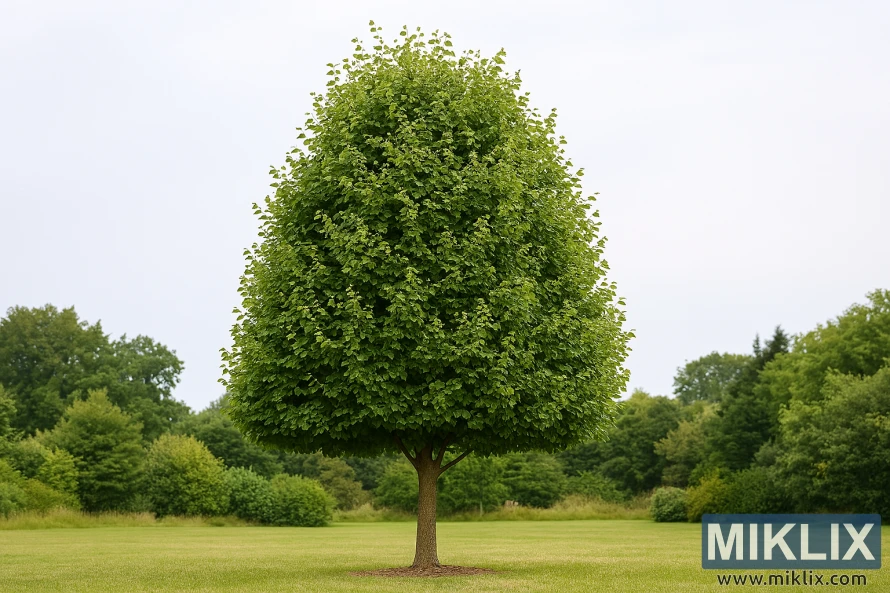
Key Characteristics:
- Size: 60-70 feet tall, 30-40 feet wide at maturity
- Growth Rate: Moderate (12-24 inches per year)
- Leaf Shape: Small, heart-shaped leaves with serrated edges
- Hardiness Zones: 3-8
- Soil Preference: Adaptable to various soils; prefers well-drained loam
- Sunlight Needs: Full sun to partial shade
Special Features:
- Exceptionally fragrant flowers that attract pollinators
- More compact size than American Linden
- Excellent urban tree tolerance
- Drought-resistant once established
- Resistant to Japanese beetles compared to other Lindens
Best Garden Uses:
- Specimen tree in medium to large yards
- Shade tree for patios and outdoor living areas
- Street tree or boulevard planting
- Pollinator gardens
American Linden/Basswood (Tilia americana)
The American Linden, also known as Basswood, is a magnificent native North American tree that brings stately presence to larger landscapes. With its massive heart-shaped leaves (often reaching 6-8 inches across) and impressive height, this Linden creates dramatic shade and serves as a commanding focal point in spacious gardens.
American Linden produces especially fragrant flowers that are highly valued by beekeepers for producing premium honey. Its wood has historically been prized for carving due to its softness and fine grain. In autumn, the foliage turns a pleasant yellow, creating a warm golden canopy.
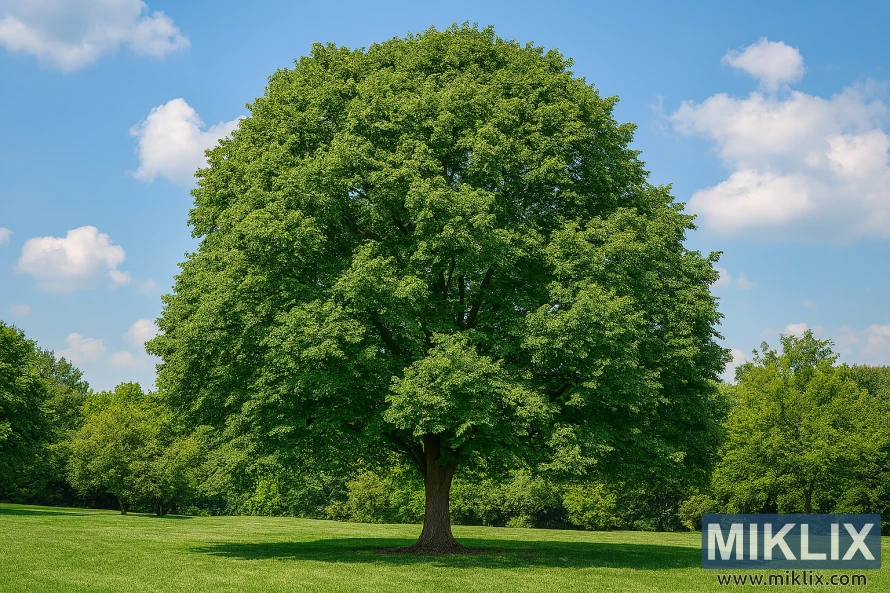
Key Characteristics:
- Size: 75-90 feet tall, 40-45 feet wide at maturity
- Growth Rate: Moderate to fast (24+ inches per year)
- Leaf Shape: Large, heart-shaped leaves with serrated edges
- Hardiness Zones: 3-8
- Soil Preference: Adaptable; prefers moist, well-drained soils
- Sunlight Needs: Full sun to partial shade
Special Features:
- Native to North America (ecological benefits)
- Exceptionally large, textured leaves
- Superior shade production
- Highly attractive to bees (produces premium honey)
- Long lifespan (300+ years possible)
Best Garden Uses:
- Specimen tree for large properties
- Shade tree for expansive lawns
- Native plant gardens
- Wildlife habitats
- Natural areas and woodland edges
Silver Linden (Tilia tomentosa)
The Silver Linden stands out among Linden varieties for its striking bicolor foliage. The leaves display a dark green upper surface with a silvery-white underside that creates a shimmering effect when stirred by the breeze. This unique characteristic makes the Silver Linden particularly captivating in windy locations.
Native to southeastern Europe and western Asia, this species offers exceptional drought tolerance once established, making it an excellent choice for drier climates. Its fragrant flowers appear slightly later than other Lindens, extending the season of bloom in your garden.
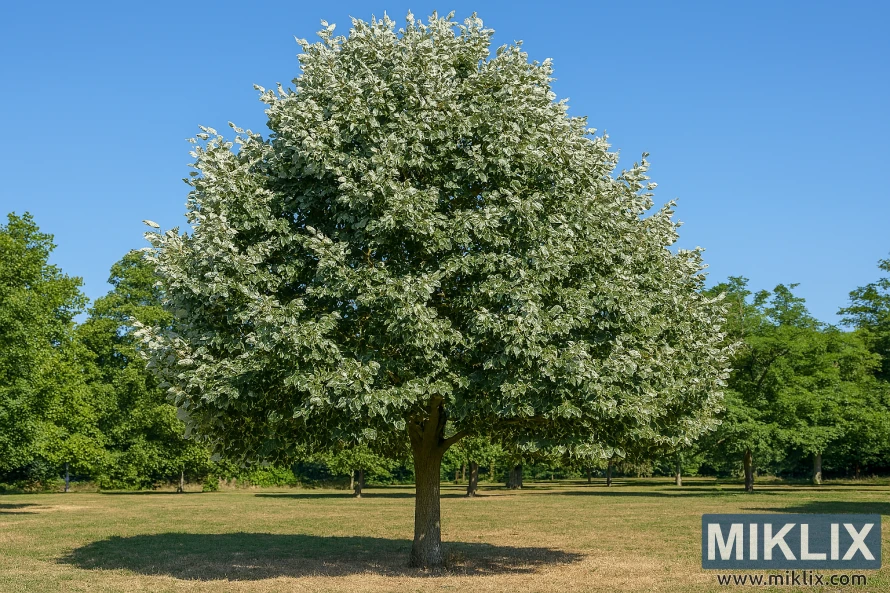
Key Characteristics:
- Size: 50-70 feet tall, 30-50 feet wide at maturity
- Growth Rate: Moderate (12-24 inches per year)
- Leaf Shape: Heart-shaped with silvery undersides
- Hardiness Zones: 4-8
- Soil Preference: Adaptable; tolerates alkaline soils
- Sunlight Needs: Full sun
Special Features:
- Striking silver leaf undersides that shimmer in the wind
- Superior heat and drought tolerance
- Later-blooming flowers (extends Linden season)
- Excellent resistance to Japanese beetles
- Urban pollution tolerance
Best Garden Uses:
- Specimen tree for visual impact
- Shade tree for drier climates
- Windbreak plantings (to showcase leaf movement)
- Urban gardens
- Drought-resistant landscapes
Crimean Linden (Tilia x euchlora)
The Crimean Linden is a hybrid between the Littleleaf and Caucasian Lindens, combining the best qualities of both parents. It features glossy, dark green leaves that maintain their rich color throughout the growing season, even during periods of heat and drought when other trees might look stressed.
This variety is particularly valued for its resistance to aphids, which can sometimes be problematic with other Linden species. The Crimean Linden's weeping branch tips create a graceful silhouette, adding movement and elegance to the landscape.
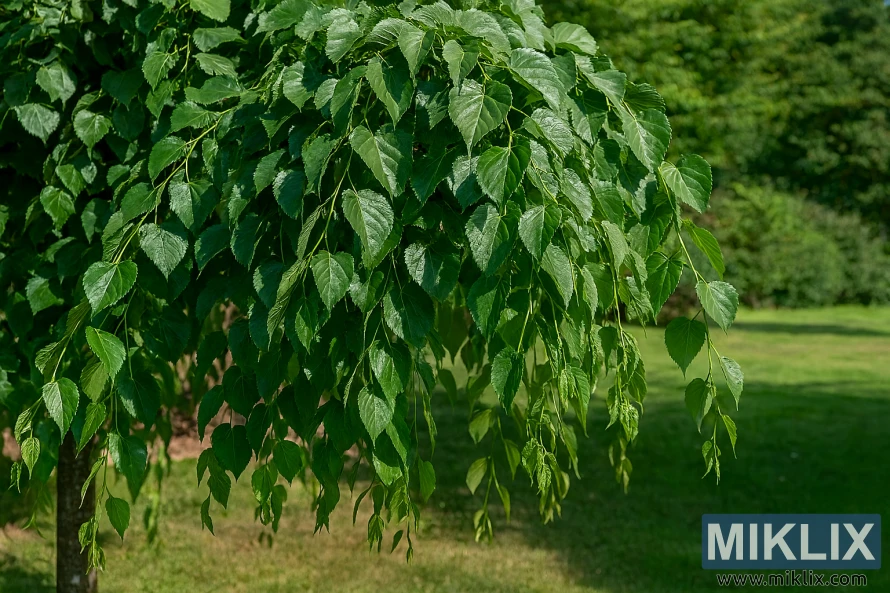
Key Characteristics:
- Size: 40-60 feet tall, 25-40 feet wide at maturity
- Growth Rate: Moderate (12-18 inches per year)
- Leaf Shape: Glossy, heart-shaped leaves with weeping branch tips
- Hardiness Zones: 4-7
- Soil Preference: Adaptable to various soils
- Sunlight Needs: Full sun to light shade
Special Features:
- Glossy, deep green foliage that resists summer browning
- Reduced aphid susceptibility compared to other Lindens
- Elegant weeping branch tips
- Good urban tolerance
- Attractive yellow fall color
Best Garden Uses:
- Clean-canopied shade tree (fewer honeydew drips)
- Street tree or driveway lining
- Specimen tree for medium-sized properties
- Parks and public spaces
Greenspire Linden (Tilia cordata 'Greenspire')
The Greenspire Linden is a carefully selected cultivar of the Littleleaf Linden that has become a landscape designer favorite for its exceptionally uniform, pyramidal shape and consistent performance. This variety maintains a strong central leader and symmetrical branching without extensive pruning, making it low-maintenance yet visually striking.
Greenspire features dark green, glossy foliage that turns an attractive yellow in fall. Its uniform growth habit makes it particularly valuable for formal plantings where consistency is desired, such as in allées, matched pairs, or street plantings.
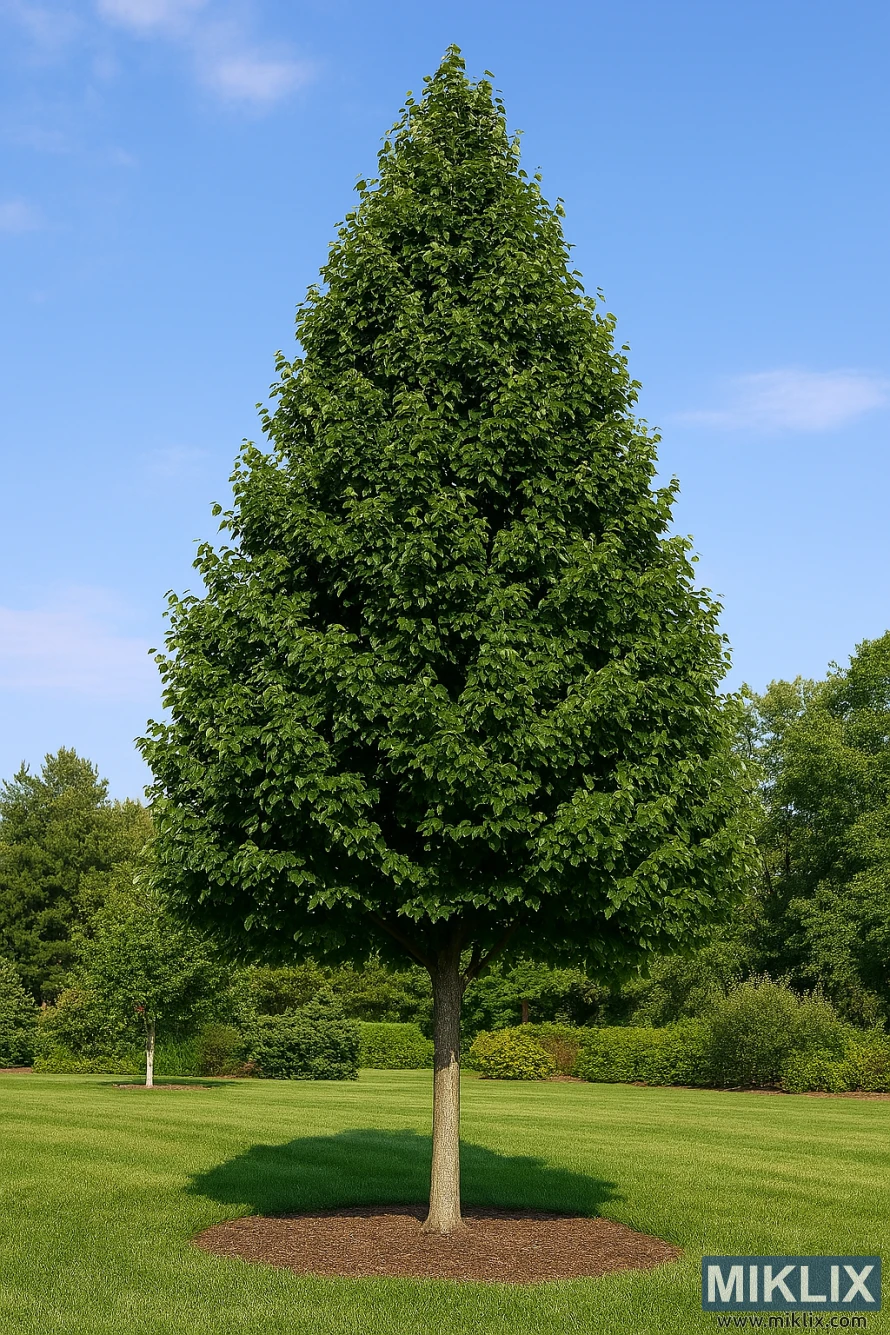
Key Characteristics:
- Size: 40-50 feet tall, 30-35 feet wide at maturity
- Growth Rate: Moderate (12-24 inches per year)
- Leaf Shape: Heart-shaped, slightly smaller than species
- Hardiness Zones: 4-7
- Soil Preference: Adaptable; performs well in urban soils
- Sunlight Needs: Full sun
Special Features:
- Perfect pyramidal form with minimal pruning
- Strong central leader
- Uniform growth habit
- Excellent street tree performance
- Consistent golden fall color
Best Garden Uses:
- Formal garden designs
- Street tree plantings
- Matched pairs flanking entrances
- Allées and driveway linings
- Urban landscapes
Redmond Linden (Tilia americana 'Redmond')
The Redmond Linden is a standout cultivar of the American Linden that combines the impressive size of its parent species with a more refined, pyramidal form. Named "Urban Tree of the Year" by the Society of Municipal Arborists, this variety offers exceptional performance in both residential and municipal settings.
Redmond features large, glossy dark green leaves that are slightly thicker than the species, giving it enhanced drought tolerance. Its symmetrical, uniform growth habit requires minimal corrective pruning, making it a low-maintenance option for creating substantial shade.
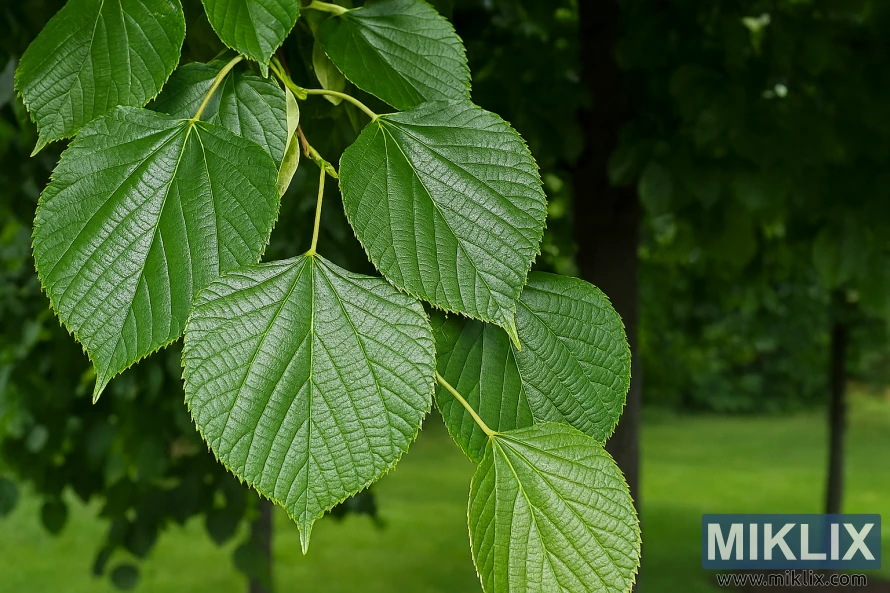
Key Characteristics:
- Size: 40-60 feet tall, 25-30 feet wide at maturity
- Growth Rate: Moderate to fast (18-24+ inches per year)
- Leaf Shape: Large, glossy, heart-shaped leaves
- Hardiness Zones: 3-8
- Soil Preference: Adaptable; tolerates clay soils
- Sunlight Needs: Full sun to partial shade
Special Features:
- Award-winning urban performance
- Larger, glossier leaves than typical American Linden
- Enhanced drought tolerance
- Symmetrical pyramidal form
- Brilliant golden fall color
Best Garden Uses:
- Shade tree for large properties
- Street tree and municipal plantings
- Parks and public spaces
- Specimen tree for substantial landscapes
Planting and Caring for Your Linden Tree
Proper planting and care are essential for helping your Linden tree establish quickly and thrive for decades to come. Follow these guidelines to give your tree the best possible start in your garden.
Soil Preparation & Planting
Linden trees adapt to various soil types but perform best in well-drained, loamy soil with consistent moisture. Before planting, take time to prepare the site properly:
- Dig a hole 2-3 times wider than the root ball but no deeper than the root ball height.
- Gently remove the tree from its container and loosen any circling roots.
- Position the tree so the root flare (where trunk widens at base) sits slightly above ground level.
- Backfill with the original soil, avoiding amendments that might discourage roots from expanding outward.
- Create a watering basin around the tree and water thoroughly after planting.
- Apply 2-3 inches of mulch in a circle around the tree, keeping it 3-4 inches away from the trunk.
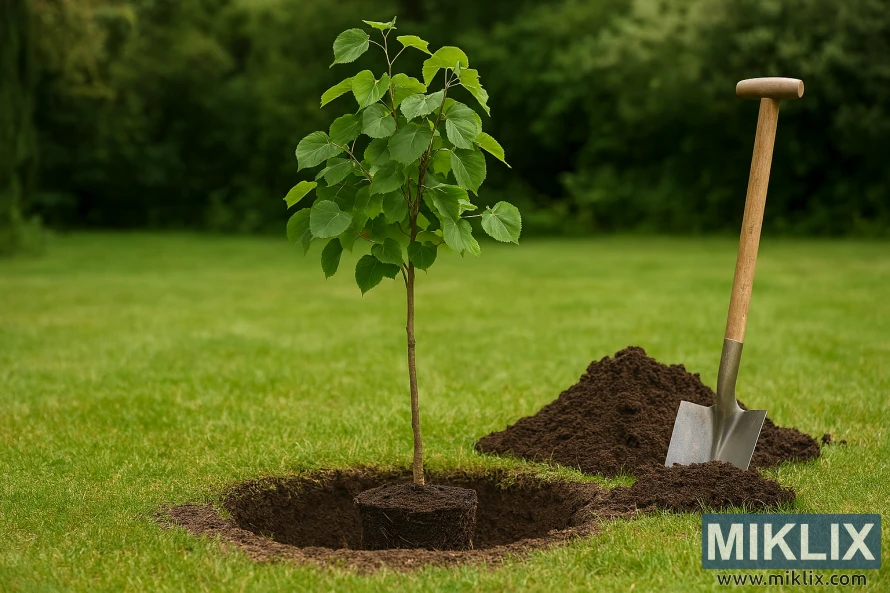
Watering & Fertilization
Establishing a proper watering routine is crucial during your Linden tree's first few years:
- Water deeply once or twice weekly during the first growing season, ensuring the soil remains moist but not waterlogged.
- Check soil moisture by inserting your finger 2-3 inches into the soil near the root zone.
- Increase watering during dry spells and reduce during rainy periods.
- After the first year, water during extended dry spells, focusing on deep, infrequent irrigation.
- Fertilize sparingly—only if soil tests indicate deficiencies or if growth seems stunted.
- If fertilizing, use a balanced, slow-release formula in early spring before new growth begins.
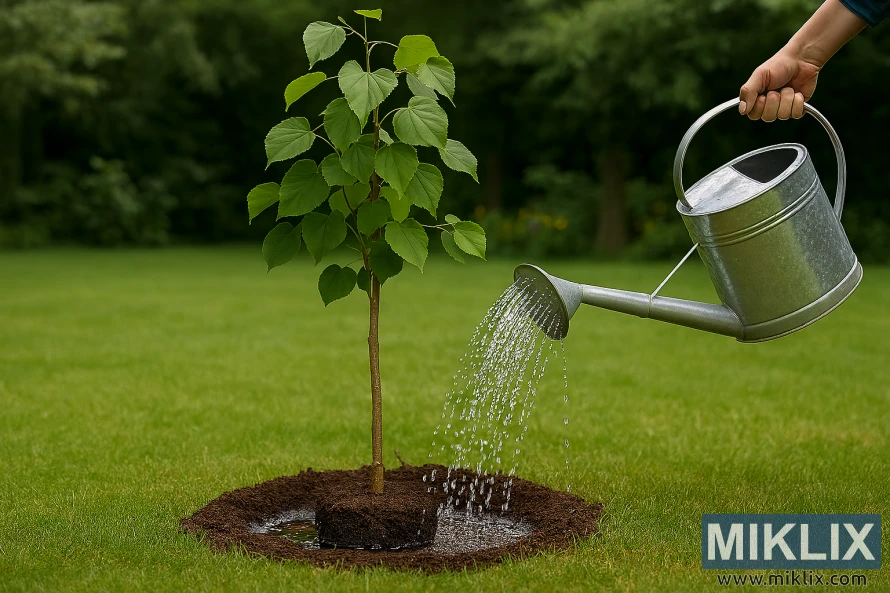
Pruning Techniques
Most Linden varieties naturally develop attractive forms with minimal intervention, but some strategic pruning can enhance their structure:
- Limit pruning to the dormant season (late winter to early spring) before new growth appears.
- Remove dead, damaged, or crossing branches first.
- For young trees, establish a strong central leader by removing competing leaders.
- Maintain the tree's natural pyramidal to oval shape rather than trying to drastically alter it.
- If planting near walkways, gradually raise the canopy by removing lower branches as the tree matures.
- Avoid removing more than 25% of the canopy in a single year to prevent stress.
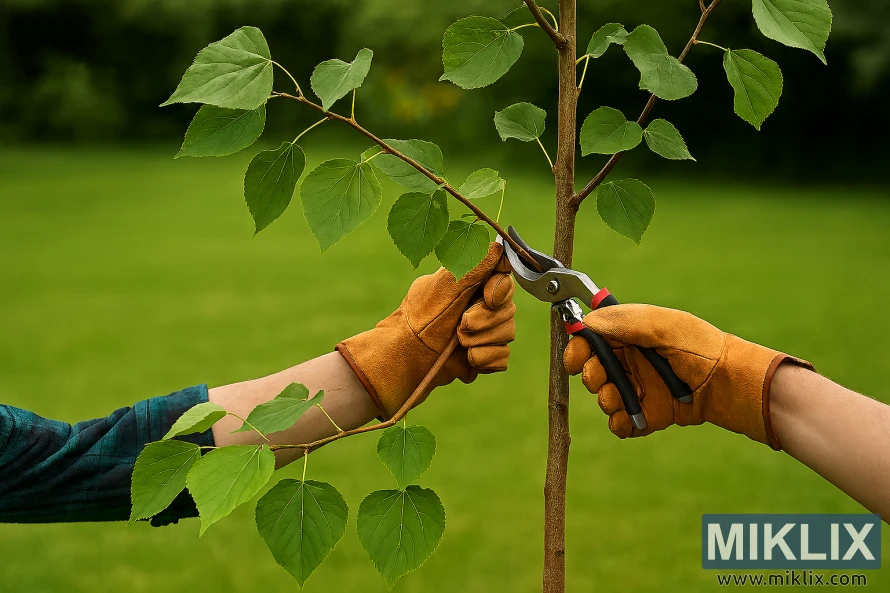
Common Pests & Diseases
While Linden trees are generally robust, they can face a few challenges. Here's how to address common issues organically:
- Aphids: These can cause sticky honeydew drips. Control with strong water sprays, insecticidal soap, or by encouraging natural predators like ladybugs.
- Japanese Beetles: These may skeletonize leaves. Hand-pick when possible or use neem oil applications. Silver and Crimean Lindens show better resistance.
- Leaf Spot Diseases: These appear as brown spots on foliage. Improve air circulation, avoid overhead watering, and remove affected leaves.
- Verticillium Wilt: This causes branch dieback. No cure exists, but proper watering and fertilization can help trees resist infection.
- Cankers: These cause sunken areas on branches. Prune affected areas in dry weather with sterilized tools.
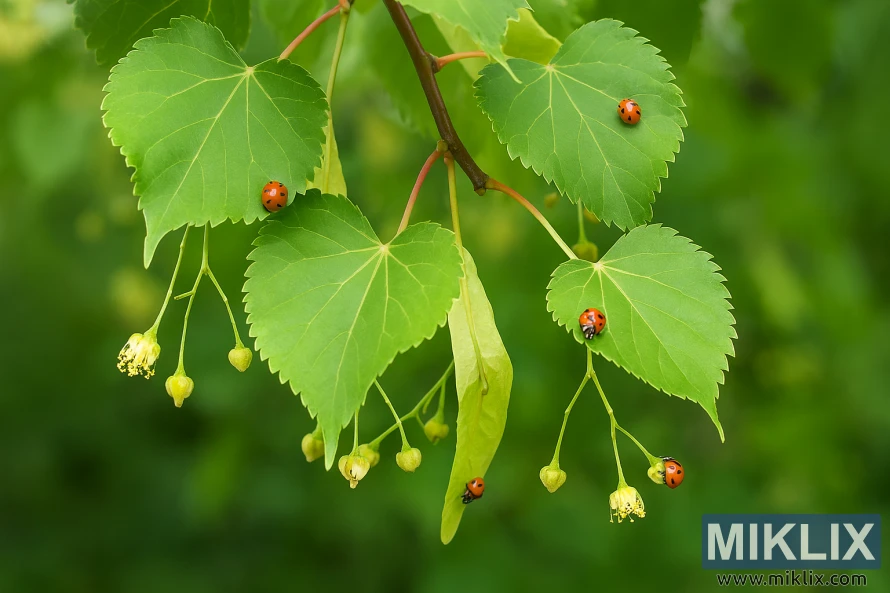
Linden Tree Care Calendar
Spring: Inspect for winter damage and prune if needed. Apply mulch if depleted. Water during dry spells as new growth emerges.
Summer: Enjoy the fragrant blooms! Monitor for pests and diseases. Water deeply during extended dry periods.
Fall: Rake fallen leaves for compost. No need to fertilize. Reduce watering as tree prepares for dormancy.
Winter: Young trees may benefit from trunk protection against sunscald and rodents. Plan any major pruning for late winter.
Get Seasonal Linden Care Tips
Sign up for our free newsletter to receive seasonal care reminders and expert advice for maintaining your Linden tree's health and beauty year-round.
Email Address
Which Linden variety are you growing? Select a variety Littleleaf Linden American Linden/Basswood Silver Linden Crimean Linden Greenspire Linden Redmond Linden Other/Not sure
Subscribe to Care Tips
Selecting the Right Linden Tree for Your Garden

For Small to Medium Gardens
If space is limited but you still want the beauty of a Linden tree, consider:
- Greenspire Linden - Maintains a narrower profile
- Crimean Linden - Moderate size with clean canopy
- Compact cultivars like 'Corinthian' or 'Monto'
These varieties provide the classic Linden experience without overwhelming smaller spaces.
For Challenging Conditions
If your site has specific environmental challenges, select accordingly:
- Silver Linden - Best for hot, dry conditions
- Crimean Linden - Reduced aphid issues
- Redmond Linden - Excellent urban tolerance
- American Linden - Adaptable to various soils
These varieties have proven themselves resilient in less-than-ideal situations.
For Specific Design Goals
If you have particular aesthetic or functional requirements:
- Formal symmetry: Greenspire Linden
- Maximum shade: American or Redmond Linden
- Visual movement: Silver Linden
- Pollinator support: Any variety (all attract bees)
Select based on the primary role you want your Linden to play in your landscape.
The Lasting Legacy of Linden Trees
Planting a Linden tree is more than just adding beauty to your landscape—it's creating a living legacy that will enhance your property for generations. These magnificent trees offer a perfect balance of ornamental appeal, ecological benefits, and practical advantages that few other species can match.
From the sweet fragrance of their summer blooms to their golden autumn display, from their wildlife support to their cooling shade, Linden trees reward gardeners with year-round interest and minimal maintenance demands. Whether you choose the native American Basswood, the elegant Littleleaf, the shimmering Silver, or one of the refined cultivars, you're investing in a tree that will become more magnificent with each passing year.
As you consider which Linden variety might be right for your garden, remember that these trees aren't just for today—they're a gift to future generations who will enjoy their shade, fragrance, and beauty long after we're gone. In a world of fleeting trends, the timeless elegance of a well-placed Linden tree stands as a testament to thoughtful, forward-thinking garden design.
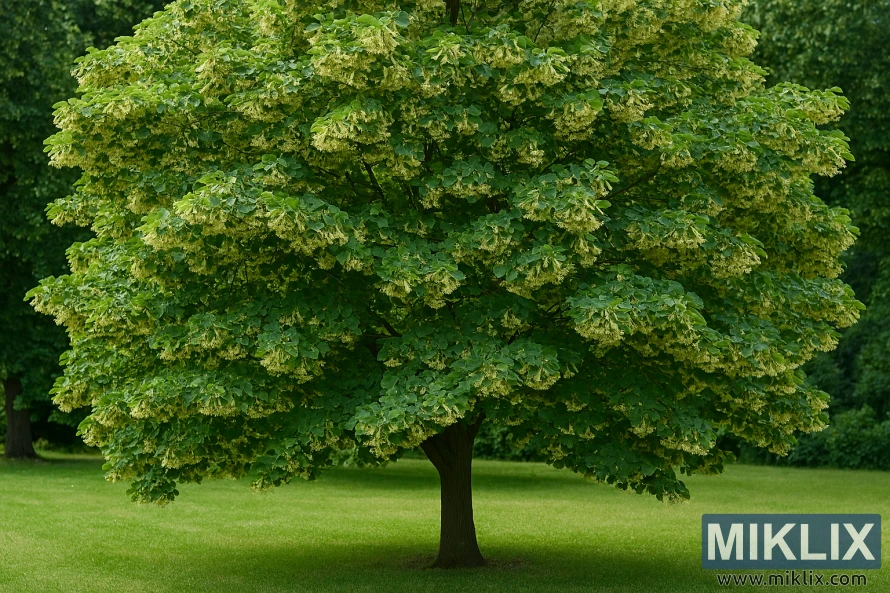
Further Reading
If you enjoyed this post, you may also like these suggestions:
- A Guide to the Best Varieties of Weeping Cherry Trees to Plant in Your Garden
- A Guide to the Best Trees to Plant in Your Garden
- The Best Crabapple Tree Varieties to Plant in Your Garden
